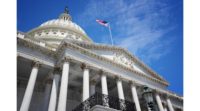Coalition of Organizations Urge Congress to Reconsider Facial Recognition

The Security Industry Association (SIA) — as part of a coalition of organizations and trade associations — has issued a letter to congress outlining its concerns regarding potential bans on public sector uses of facial recognition technology. The letter authors encourage the federal government to collaborate with all stakeholders to address concerns about the use of facial recognition technology and recommend federal leaders provide a consistent set of rules across the United States.
In the Oct. 16 letter to House Speaker Nancy Pelosi (D-Calif.), House Minority Leader Kevin McCarthy (R-Calif.), Senate Majority Leader Mitch McConnell (R-Ky.) and Senate Democratic Leader Charles Schumer (D-N.Y.), the coalition — which includes SIA, the Airports Council International – North America, the American Association of Airport Executives, the Consumer Technology Association, the Global Business Travel Association, the Identification Technology Association, the Information Biometrics + Identity Association, NetChoice and the U.S. Chamber of Commerce — outlined the history of facial recognition and its prevalent use across various industries, the potential consequences of a moratorium on the technology and recent innovation and work to ethically and responsibly govern the technology.
“Recent calls for bans on facial recognition technology are based on a misleading picture of how the technology works and is used today,” said Don Erickson, CEO of SIA. “Facial recognition technology has benefited Americans in many ways, such as helping to fight human trafficking, thwart identity thieves and improve passenger facilitation at airports and enhance aviation security. As a representative of companies that provide and leverage facial recognition, SIA believes this advanced technology should be used in a safe, accurate and effective way, and we look forward to working with congress to help the U.S. set the example on how to ethically and responsibly govern this technology.”
As part of its ongoing efforts to address confusion about facial recognition and increase awareness of its beneficial uses, SIA recently produced the resource Face Facts: Dispelling Common Myths Associated With Facial Recognition Technology. This document explores the facial recognition technology landscape and how the technology works, outlines how government and law enforcement use the technology and addresses confusion and common myths. Additionally, the resource shares examples of effective use of the technology to help locate missing children, mitigate travel document fraud and improve processes like storefront security and mobile banking.
Looking for a reprint of this article?
From high-res PDFs to custom plaques, order your copy today!





